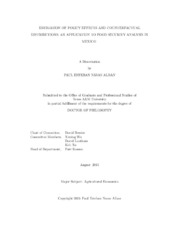| dc.description.abstract | The analysis of the effects of a policy and the factors that mediated those effects are among the core objectives of the economic science. The aim of this investigation is to present a recent methodological breakthrough in this field named distribution regression and to use it conjointly with causal analysis, to estimate the effects of a policy. The novelty relies in the estimation not only of the expectation of the difference between observed and counterfactual outcome, the usual Average Treatment Effect, but of the entire distribution of this counterfactual random variable and its distribution as a stochastic process. This estimation uses tools stemming from the field of Empirical Processes, to allow for the estimation of these counterfactual distributions, which will be supported with the methods of machine learning and causal analysis to tackle the problem of the causality structure among a set of variables and to attempt to justify the causal interpretation of the counterfactual distributions obtained.
These new tools of policy analysis are applied to the 2012 avian flu outbreak in Mexico in July. The variable of interest in the analysis is the food security of the population, with the research question driving this application being whether there was a negative effect in the nutritional status of the population, in particular that of rural areas, once other factors such as household expenditure, educational status and others have been controlled for; estimating counterfactual distributions of what would have happened to the whole and to specific portions of the population had the outbreak not occurred finds that the average treatment effect is significant, both for the before and after comparison and for the rural and urban comparison in the expected way, with the outbreak reducing the food security of the population, with factors as the number of household members, whether the family experienced a set-back and the gender of the provider being the driving forces. Another set of findings shows that it is not possible to conclude that the effects are heterogeneous on the population, since the quantile treatment effects are not statistically significant using uniform confidence intervals for any of the different setups investigated. | en |


